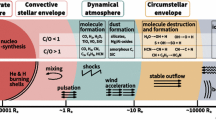Abstract
A possible scenario for the evolution of the universe following the big bang at t > 10-5 sec is considered. The necessary conditions that must be present for the formation of stars and stellar systems to be possible are formulated. As a condition for the formation of stars we take kTs≤ GMsmp(3R), and for stellar systems HR ≲ (GM/R)1/2, where Ts is the temperature of the cosmic plasma, mp is the mass of a proton, Ms is the mass of a star, M is the mass of a stellar cluster, R is the radius of these celestial bodies, and H is the bubble parameter for the corresponding time. In accordance with these criteria, we assume that in the course of cosmological expansion, neutron stars should have been formed first (times 2.10-4 ≲ t ≲ 1 sec, densities 0.07 ≲ ρB≲ 2.104 g/cm3) and then, in chronological order, appeared white dwarfs (t ≈ 102 sec, ρB ≲ 5.10-3 g/cm3), ordinary stars (t ≈ 4.106 sec, ≲B ≈ 10-11 g/cm3), galactic nuclei (t ≈ 3.1011 sec, ≲B ≈ 5.10-19 g/cm3, globular clusters (t ≈ 1013 sec, ≲B ≈ 4.10-21 g/cm3), and galaxies (t ≈ 1015 sec, ≲B ≈ 10-24 g/cm3), where ≲B is the average density of ordinary (baryon) matter in the universe. It is shown that a galactic nucleus is a stellar system in statistical equilibrium and consists mainly of neutron stars and white dwarfs. The formation of some pulsars (neutron stars with angular rotation rates 1 < Ω < 200 sec-1) may occur in a galactic nucleus. Observed pulsars should therefore contain some fraction of neutron stars from the nucleus of the Galaxy that were able to escape it over the relaxation time (the tail of the Maxwell distribution, with star velocities v > v0, where v0 is the velocity corresponding to the work function 2GMMs/R, M being the mass and R the radius of the Galaxy’s nucleus.
Similar content being viewed by others
Literature Cited
L. Sh. Grigorian and G. S. Sahakian,Astrophys. Space Sci.,95, 305 (1983).
G. S. Sahakian,Physics of Neutron Stars [in Russian], Dubna (1995).
J. Einasto, “Hypergalaxies,” in:The Large-Scale Structure of the Universe, J. Einasto and M. S. Longair (eds.), Kluwer Academic, Hingham, Me (1978).
V. A. Ambartsumian,Scientific Works [in Russian], Vol. 1, Akad. Nauk Arm. SSR, Erevan (1960), p. 158.
R. N. Manchester and J. H. Taylor,Pulsars, W. H. Freeman, San Francisco (1977).
C. W. Allen,Astrophysical Quantities, Academic Press, New York (1973).
G. S. Sahakian,Equilibrium Configurations of Degenerate Gaseous Masses, Wiley, New York-Toronto (1974).
M. Schwarzschild,Structure and Evolution of the Stars, Princeton Univ. Press, Princeton (1958).
G. S. Sahakian, G. P. Alodzhants, and A. V. Sarkisian,Astrofizika,34, 21 (1991).
A. G. Doroshkevich, Yu. N. Efremov, A. V. Zasov, et al.,Origin and Evolution of Galaxies and Stars [in Russian], S. B. Pikel’ner (ed.), Nauka, Moscow (1976).
V. A. Ambartsumian,Scientific Works [in Russian], Vol. 2, Akad. Nauk Arm. SSR, Erevan (1960).
Author information
Authors and Affiliations
Additional information
The beginning of the paper was printed in the previous number of the journal [Astrofizika, No. 1, 117–124 (1997)].
Translated from Astrofizika, Vol. 40, No. 2, pp. 253–271, April–June, 1997.
Rights and permissions
About this article
Cite this article
Sahakian, G.S. Main stages of evolution of matter in the universe. II. Astrophysics 40, 167–177 (1997). https://doi.org/10.1007/BF03036110
Received:
Issue Date:
DOI: https://doi.org/10.1007/BF03036110




